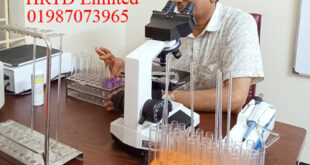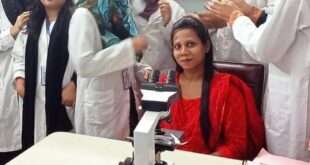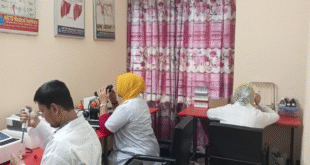Lipid Profile Test Training (Mobile 01797522136) is part of practical of Clinical Biochemistry . Clinical Biochemistry is a subject of Pathology , Paramedical, DMS, LMF and many other courses of HRTD Medical Institute.

Introduction of Lipid Profile Test Training
The field of medical diagnostics has grown rapidly in recent decades, and laboratory testing plays an integral role in the prevention, diagnosis, and management of diseases. Among the numerous diagnostic tests available, the lipid profile test holds significant importance. This test provides crucial information about the levels of cholesterol and triglycerides in the blood, which are key indicators of cardiovascular health. Given the increasing prevalence of heart disease, obesity, diabetes, and lifestyle-related disorders, the demand for skilled professionals who can accurately conduct and interpret lipid profile tests has grown substantially.
To meet this growing need, specialized training institutes are stepping forward to equip students and healthcare workers with practical knowledge and laboratory expertise. HRTD Medical Institute, located in Mirpur, Dhaka, has established itself as a leading center for medical training and diagnostics, offering structured courses on various laboratory tests, including the lipid profile test. Through its dedicated training programs, HRTD Medical Institute aims to enhance the quality of healthcare professionals in Bangladesh and beyond.
This comprehensive article will explore the importance of the lipid profile test, the procedures involved, its clinical significance, and the unique role of HRTD Medical Institute in training future professionals to master this vital diagnostic tool.
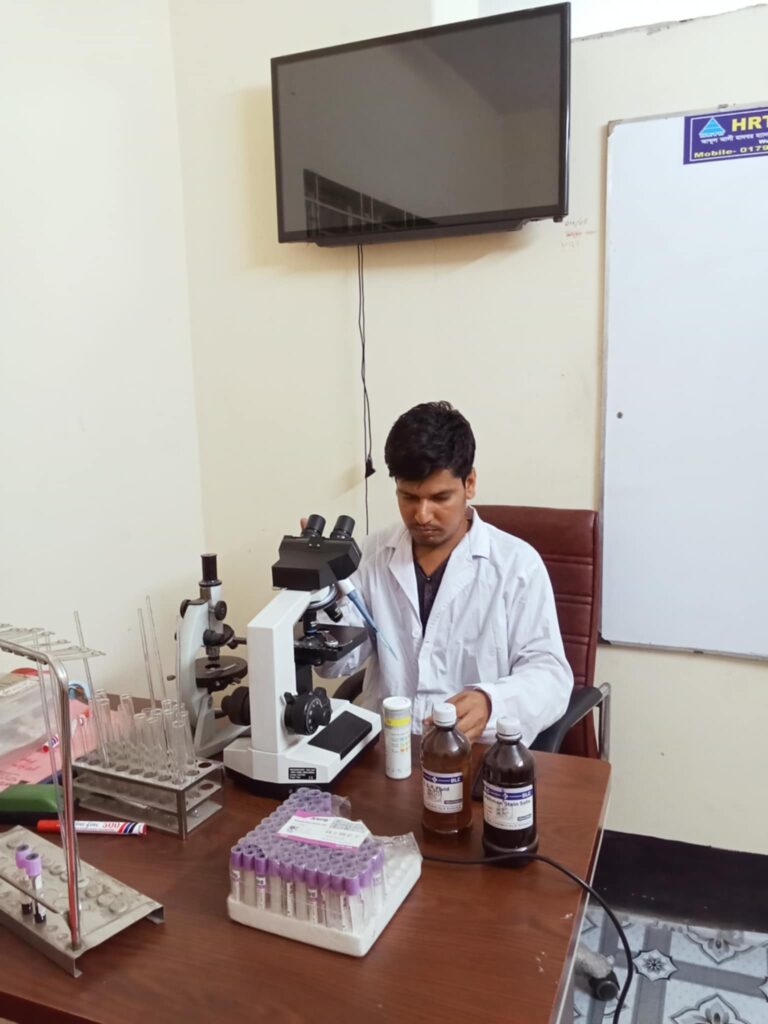
Understanding the Lipid Profile Test
A lipid profile test, also known as a lipid panel, is a blood test that measures the amount of cholesterol and triglycerides in the body. It typically includes the following components:
- Total Cholesterol (TC): Provides the overall level of cholesterol in the blood.
- Low-Density Lipoprotein Cholesterol (LDL-C): Often referred to as “bad cholesterol,” high levels of LDL can lead to plaque buildup in the arteries.
- High-Density Lipoprotein Cholesterol (HDL-C): Known as “good cholesterol,” HDL helps remove LDL from the bloodstream.
- Triglycerides (TG): A type of fat in the blood that, in high amounts, increases the risk of heart disease.
- VLDL (Very Low-Density Lipoprotein): Carries triglycerides in the blood and contributes to plaque formation.
The test is generally performed after a fasting period of 9–12 hours for accurate results. Doctors use lipid profile test results to evaluate a patient’s risk of developing cardiovascular disease, to monitor ongoing treatments, and to assess overall metabolic health.
Importance of the Lipid Profile Test
The lipid profile test is crucial because cardiovascular diseases (CVDs) remain the leading cause of death worldwide. High cholesterol and triglyceride levels are major risk factors for conditions such as atherosclerosis, stroke, and coronary artery disease. Here are some reasons why the lipid profile test is indispensable:
- Early Detection of Risk Factors: Identifies abnormal lipid levels before symptoms of heart disease appear.
- Guidance for Treatment: Helps doctors prescribe lifestyle changes, medications, or further interventions.
- Monitoring Progress: Assesses the effectiveness of treatment strategies such as statin therapy or dietary modifications.
- Prevention of Complications: Reduces the risk of severe health issues by enabling timely intervention.
Given this importance, laboratory professionals must be thoroughly trained to perform the lipid profile test accurately. Errors in sample collection, storage, or analysis can lead to false results, potentially putting patients at risk. This highlights the value of specialized training programs.
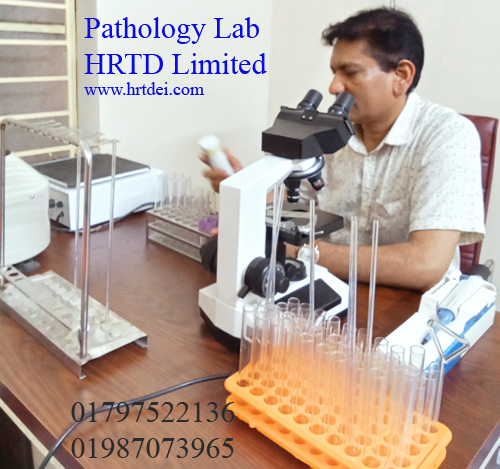
Lipid Profile Test Procedure
Training students to perform the lipid profile test requires a systematic understanding of both theory and practice. The procedure typically involves:
- Patient Preparation: Patients are instructed to fast for 9–12 hours. Water intake is allowed, but no food or other drinks should be consumed.
- Sample Collection: Blood is drawn from a vein in the arm using aseptic techniques.
- Sample Handling: Collected samples must be stored properly and transported to the laboratory without delay.
- Laboratory Analysis: Automated analyzers or manual methods are used to determine lipid concentrations.
- Result Interpretation: Results are compared against standard reference ranges to evaluate patient health.
Each of these steps requires precision and attention to detail. A properly trained medical technologist ensures accurate test outcomes and patient safety.
Clinical Relevance of Lipid Profile
Lipid profile results provide valuable information about a patient’s cardiovascular health. For instance:
- High LDL and Triglycerides: Indicate an increased risk of plaque formation in the arteries, leading to heart disease.
- Low HDL: Suggests the body has less “good cholesterol” to clear excess LDL.
- Balanced Lipid Levels: Reflect healthy metabolic and cardiovascular function.
Understanding how to interpret these results is just as important as performing the test. At HRTD Medical Institute, students not only learn laboratory techniques but also gain insights into the clinical significance of their work.
Need for Lipid Profile Test Training in Bangladesh
Bangladesh faces a growing burden of non-communicable diseases, including heart disease, diabetes, and obesity. With limited awareness about preventive healthcare and diagnostic testing, there is an urgent need for skilled laboratory professionals who can contribute to early detection and management.
Unfortunately, many laboratories in smaller towns and rural areas still lack adequately trained personnel. Inaccurate results can mislead doctors and compromise patient care. This gap underscores the necessity for specialized training centers like HRTD Medical Institute, which not only provide technical skills but also instill professional ethics and quality assurance practices.
HRTD Medical Institute: A Pioneer in Lipid Profile Test Training
Located in Mirpur, Dhaka, HRTD Medical Institute is a trusted name in healthcare education. With state-of-the-art facilities and experienced faculty, the institute is committed to shaping the next generation of healthcare professionals. The lipid profile test training program is one of the many specialized courses offered here.
Key features of HRTD Medical Institute’s training include:
- Comprehensive Curriculum: Covering theoretical knowledge, laboratory techniques, and clinical interpretation.
- Hands-on Training: Students work with modern diagnostic equipment under expert supervision.
- Focus on Quality Control: Emphasis on accuracy, reliability, and ethical standards in laboratory testing.
- Career Development: Guidance on job placement and professional growth in the medical diagnostic sector.
Through these initiatives, HRTD Medical Institute plays a pivotal role in advancing diagnostic healthcare standards in Bangladesh.
The Training Program: Step-by-Step
The lipid profile test training course at HRTD Medical Institute is designed to balance theory with practical exposure. Students undergo the following stages:
- Introduction to Lipids and Cardiovascular Health: Understanding the biological role of lipids and their impact on human health.
- Principles of Lipid Testing: Learning about the chemistry, analyzers, and methodologies involved.
- Sample Collection Techniques: Training in venipuncture and safe handling of biological specimens.
- Laboratory Practices: Hands-on sessions on lipid profile test procedures using both manual and automated methods.
- Result Analysis and Interpretation: Developing skills to compare test results with standard references and provide reliable reports.
- Quality Assurance in Testing: Implementing international standards for laboratory accuracy.
- Case Studies and Clinical Applications: Applying knowledge to real-world scenarios.
By the end of the program, students are confident in performing the lipid profile test independently and responsibly.
Benefits of Lipid Profile Test Training at HRTD Medical Institute
- Expert Faculty: Experienced instructors guide students with practical insights.
- Modern Facilities: Well-equipped laboratories for real-time learning.
- Affordable Education: Cost-effective programs to make training accessible to all.
- Certification: Recognized certifications that enhance career opportunities.
- Community Impact: Graduates contribute to improving healthcare services in Bangladesh.
Career Opportunities After Lipid Profile Test Training
Students completing the lipid profile test training course can pursue careers in:
- Diagnostic laboratories
- Hospitals and clinics
- Research institutions
- Public health organizations
- Private healthcare centers
With the growing demand for healthcare services in Bangladesh and abroad, trained professionals enjoy excellent job prospects.
FAQ: Lipid Profile Test Training
1. What is a Lipid Profile Test?
A lipid profile test is a blood test that measures different types of fats (lipids) in the blood, such as total cholesterol, LDL, HDL, and triglycerides. It helps assess the risk of heart disease, stroke, and other health conditions.
2. what is the educational qualification for Lipid Profile Test Training?
SSC/ HSC/ Degree in any background and any passing year
3. Who can enroll in Lipid Profile Test Training?
The Lipid Profile Test Training is suitable for:
- Medical students
- Laboratory technicians
- Nurses and paramedics
- Health science students
- Anyone interested in learning diagnostic laboratory techniques
4. What topics are covered in Lipid Profile Test Training?
Typical training includes:
- Basics of lipid metabolism
- Principles of lipid testing
- Sample collection and handling
- Laboratory methods for lipid profile testing
- Quality control in lipid testing
- Clinical interpretation of results
- Case studies and practical sessions
5. How long is the lipid Profile Test Training program?
The duration depends on the institute and course structure. It may range from a few days of intensive workshops to several weeks of detailed training, including both theory and practical sessions.
6. What skills will I gain from this Lipid Profile Test Training?
After completing the Lipid Profile Test Training, you will be able to:
- Perform lipid profile tests independently
- Ensure accuracy in laboratory practices
- Identify and troubleshoot common errors
- Explain test results in a clinical context
How many cost for Lipid Profile Test Training?
It is depends on course duration.
Conclusion
The lipid profile test is a cornerstone of preventive healthcare, playing a vital role in the diagnosis and management of cardiovascular diseases. As the need for accurate and reliable testing grows, so does the demand for skilled laboratory professionals. Training institutes like HRTD Medical Institute stand at the forefront of this movement, empowering students with the knowledge, skills, and confidence needed to excel in the medical field.
By offering structured and affordable training programs, HRTD Medical Institute not only addresses the skills gap in diagnostic healthcare but also contributes to a healthier future for Bangladesh. With a strong commitment to excellence, ethics, and innovation, the institute continues to build a generation of healthcare professionals who are well-prepared to serve society.
 Pathology Training Institute in Bangladesh Best Pathology Training Institute in Bangladesh
Pathology Training Institute in Bangladesh Best Pathology Training Institute in Bangladesh


